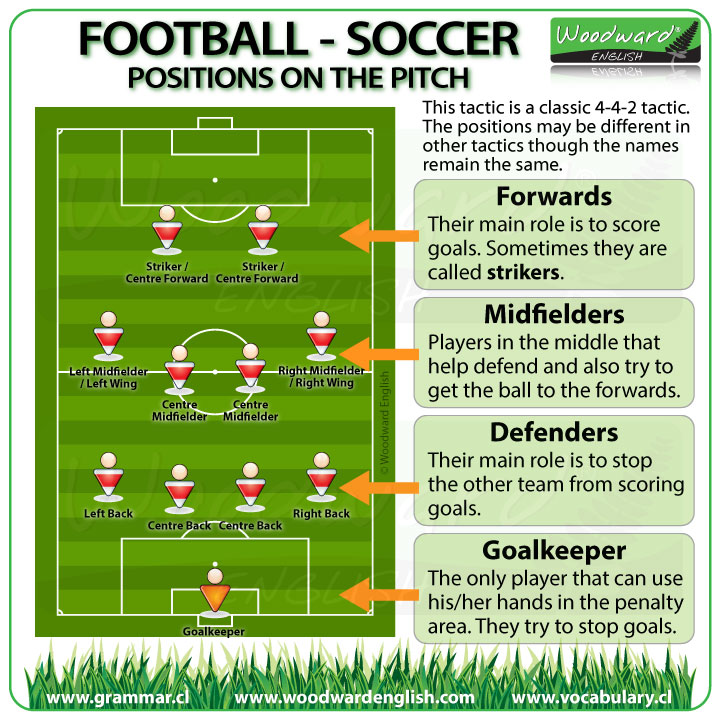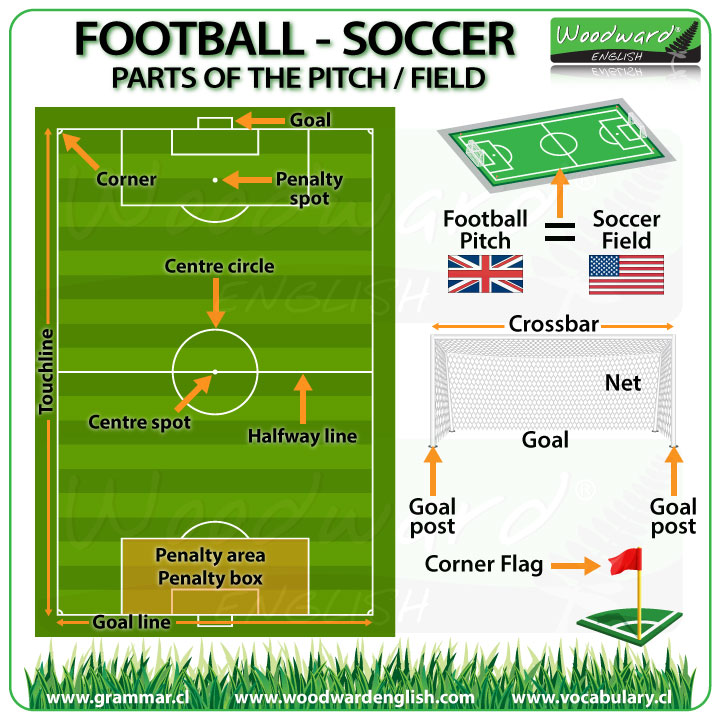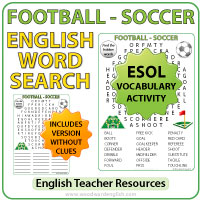Football / Soccer
English Vocabulary
What is the most popular sport in the world?
Football… also known as soccer in some countries.
Football is used in British English.
Soccer is used in American English.
Football is basically a game where two teams of eleven players each try the end a game with the most goals. The game is on a rectangular pitch or field and none of the players can use their hands to touch the ball except for one goalkeeper in each team.
A game of football lasts 90 minutes. This is divided into two halves of 45 minutes each. There is a 15-minute break between the first half and the second half.

People on the pitch / field
Pitch is used in British English
Field in used in American English
A football team consists of 11 players on the field at the same time. Two teams play against each other and there is a referee to make sure everyone follows the rules of the game.
Let’s look at some of the people involved in a game of football:
Goalkeeper: There is only one goalkeeper on the field for each team. Their main role is to defend the goal and stop the other team from scoring goals. They can use their hands while they are in the goal area. An informal word for goalkeeper is goalie.
The three main positions on the pitch are as a defender near their own goal, in the midfield, which is the centre section, and the forward position where they try to score goals.
Defender: these players play near their goalkeeper to help defend their goal.
Midfielder: a player who plays between the forwards and the defenders. They sometimes help defend, sometimes they help attack, though they spend most of the time in the middle of the pitch.
Forward: an attacking player in a team. When a forward has the main role of scoring goals, he or she can be called a striker.
Substitute: this is a player that does not start on the field with the other players. They sit on the bench until it is time to replace a player on the field that is tired on not performing well. Sometimes substitutes are used as a part of a change in tactics.
Manager: the person in charge of a football team. They are responsible for selecting the team of players for a match and the tactics they should use on the pitch.
The following are responsible for running the game:
Referee: The person responsible for making sure all players follow the rules. The referee uses a whistle to get the attention of the players and to signify a change in the flow of the game such as a foul or the end of the half or match.
Linesman: a person who helps the referee. There are two linesmen, one on each side of the pitch. The general job of a linesman is to let the referee know when the ball has gone out (has crossed the side line or goal line), when a playing is offside, or if a player commits an offense. They use a flag to indicate the situation to the referee. Another word for linesman is referee’s assistant.

Parts of a football pitch
The playing surface for soccer/football with its markings to show the area of play is called a soccer field or soccer pitch (or football field or football pitch). It consists of the following:
Bench: the area where substitute players sit and wait to be asked to enter the game.
Centre circle: this is the circle that is 10 yards (9.15 metres) from the centre mark of the pitch. When a team kick-offs at the start of a half or after a goal, players from the opposing team cannot be inside that circle until the ball has been played.
Centre spot: This is the mark in the exact middle of the centre circle where kick-off takes place.
Corner: one of the four corners of the pitch. A corner flag is placed here and it is where corner kicks are taken.
Crossbar: the horizontal bar of the goal. It must be 8 feet (2.44 metres) above the ground.
Goal: The goal consists of two vertical goal posts and a horizontal crossbar. There is normally a net attached to these to help confirm whether the ball has entered between the posts or not.
Goal line: the two short boundary lines at opposite ends of the pitch. The goal posts are placed on the goal line.
Goal post: A goal consists of two vertical goal posts that are 8 yards (7.32 metres) apart.
Halfway line: The marked line that goes across the pitch exactly halfway between the two goal lines.
Net: Nets are attached to the goal posts and crossbar and are placed behind the goal to make it easier to know when the ball enters the goal.
Penalty area: This is also known as the penalty box. This is the marked area near each goal in which the goalkeeper can use his hands to touch the ball. If a foul happens inside the penalty box, it becomes a penalty instead of a free kick.
Penalty spot: (also know as penalty mark) a white mark in the penalty box from which penalties are taken. This spot or mark is 12 yards (11 metres) from the goal line.
Stands: this is where the fans / supporters sit in the stadium around the pitch
Touchline: The touchlines are the marked lines going along the longest part of the pitch. A ball must completely cross the touchline to be out of play. If any part of the ball is still on or above the touchline, the ball is still in play. When a ball is completely out of play, a throw-in is giving to the opposite team of the last person who touched the ball.
Things that happen in a football game
Bicycle kick: when a player kicks the ball backwards over his own head to try and score a goal.
Clearance: a defensive kick that is intended to remove the ball out of danger from the goal area.
Corner kick: a free kick taken from one of the corners of the pitch. A corner kick is given when the ball touches a defending team’s player before going over the goal line (outside of the goal).
Dive: when a player deliberately falls over when tackled, mostly when they aren’t even touched. Some unscrupulous players do this act in order to get a free kick or a penalty.
Draw / Tie: when the game finishes with both teams having the same amount of goals scored.
Equalizer: a goal that is scored that brings the game to where both teams now have the same number of goals.
Extra time: Two extra 15-minute periods played when the main 90-minute game ends in a draw and a winner is needed in the competition.
Free kick: A player who is fouled by an opponent is given a free kick. It this happens inside the penalty box / goal area, then instead of a free kick, it becomes a penalty.
Foul: an action that is not permitted in the game as it is against the rules. A foul gives the other team a free kick.
Goal: when the ball passes the line between the two goal posts and under the crossbar, it is a goal. The ball must wholly cross the goal line between the goal posts before a goal is scored.
Half time: the short 15-minute break after the first half and before the second half starts.
Handball: when a player touches the ball with his/her hand or arm. The other team receives a free kick or a penalty if this happens inside the goal area.
Hat trick: when a player has scored three goals in the same match.
Header: a shot at goal that involves using the head to guide the direction of the ball.
Injury time: Extra minutes added to the end of a half in order to compensate lost playing time due to injury. This is sometimes called stoppage time.
Kick-off: the first kick of the game which signifies the start of the match. It is usually written as kickoff (one word) in American English.
Offside: when a player receives a pass and they are closer to their opponent’s goal than one of the opposite team’s players excluding the goalkeeper.
Own goal: when a player accidentally helps the ball go into their own goal.
Penalty: a free kick from the penalty spot. This kick is made by one player against the goalkeeper of the opposite team.
Penalty shootout: This happens when the game is tied (both teams have the same number of goals) after extra time in a competition and a winner needs to be decided. Each team takes turns with a penalty kick. The team that gets the most goals after their five shots, wins. If both teams have the same amount of goals after their five shots each, they each have another penalty shot each until there is a winner.
Possession: the total amount of time a team is able to keep the ball and prevent the opposition from touching it.
Red card: If a player gets a red card, they must leave the pitch immediately and cannot play again during the same match. A player is given a red card for dangerous play on the field or if they get two yellow cards in the same match.
Shot: when the ball is kicked or headed in the direction of the opponent’s goal in an attempt to score a goal.
Throw-in: When a ball goes completely across the touchline to be out of play, a throw-in is giving to the opposite team of the last person who touched the ball. This is the only time a player can use their hands to touch the ball, in this case only to throw the ball back into play.
VAR: This is short for Video Assistant Referees. This system is where the referee can replay the video of events that happened on the field. This can help the referee make decisions such as whether to award a goal or not, give a penalty, or give a player a red card.
Wall: when some players from one team stand together in a line to create a barrier or “wall” between the ball and the goal when there is a free kick.
Yellow card: A yellow card is given as punishment for a serious foul in the game. When the same player receives two yellow cards in a match, then it becomes a red card and that player must leave the game immediately.
Verbs used in Football
To concede (a goal): when a team receives a goal against them.
To cross: to pass the ball from one side of the pitch to the opposite side or into the goal area.
To dribble: to move the ball along with your feet as you go up the field.
To head: to use your head to make the ball go in a certain direction.
To kick: to strike the ball with your foot.
To mark: to guard an opposing player to try and stop them from receiving the ball from their teammate or to make it difficult for that player to use the ball how they want.
To pass: when a player kicks (or heads) the ball to another player on their same team
To score (a goal): to get a goal
To shoot: when the ball is kicked in the direction of the opponent’s goal in an attempt to score a goal.
To substitute: (to sub) to replace one player on the field with another player that was on the bench.
To tackle: to challenge and try and take the ball from an opposing player.
To volley: to kick a moving ball before it hits the ground.
What do you wear in Football?
Teams get changed in the locker room, which is sometimes called the changing room.
But what does a football player wear?
Armband: the captain wears an armband to let the referee know that he/she is the captain.
Boots: special leather shoes, in this case used for playing football.
Gloves: The goalkeeper wears gloves on his hands to make it easier to stop the ball.
Kit: the football kit refers to the whole uniform that a player wears.
Shin pads / Shin guards: protective plastic coverings that protect a player’s shins from getting hurt should they get kicked. The shin is the lower front part of the leg.
Shirt / Jersey: The top part of a team uniform that a player wears. It has a number on the back with the player’s name above that number. The goalkeeper wears a difficult colour from all the other players on the pitch.
Shorts: short trousers that only reach to the knees or thighs.
Socks: a piece of clothing that covers the foot. In football, socks are long and go up to the knee.
Studs: small projections fixed to the base of footwear that help the player to not slip over on the pitch. Sometimes studs are called sprigs.
The soccer ball / The football
The ball is round and made of leather or similar material. The ball used in professional football leagues and in the FIFA World Cup is called a size 5 ball. It has a specific size (circumference: 68-70 cm /27-28 in) and weighs (410-450gr / 14-16 oz).
The FIFA World Cup
The FIFA World Cup is an international football/soccer competition held every 4 years between the 32 qualifying nations. The winning country becomes the world champion.
In 2014 the competition was held in Brazil and Germany was the champion.
In 2018 the competition was held in Russia and France was the champion.
In 2022 the competition will be held in Qatar and the champion will be...
Next activites
Play our interactive game to practice this vocabulary: Football / Soccer Vocabulary Game
What is your favourite football team?
English Teacher Resource

If you found this vocabulary about Football / Soccer interesting or useful, let others know about it.
